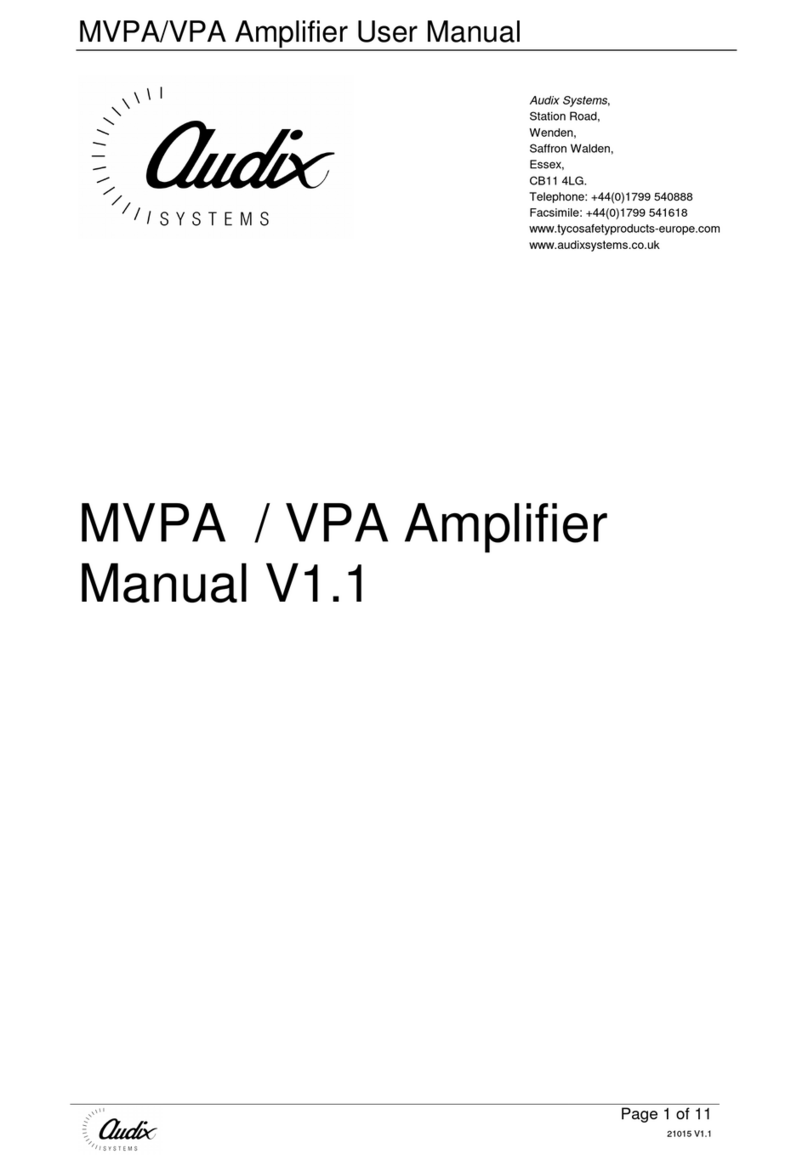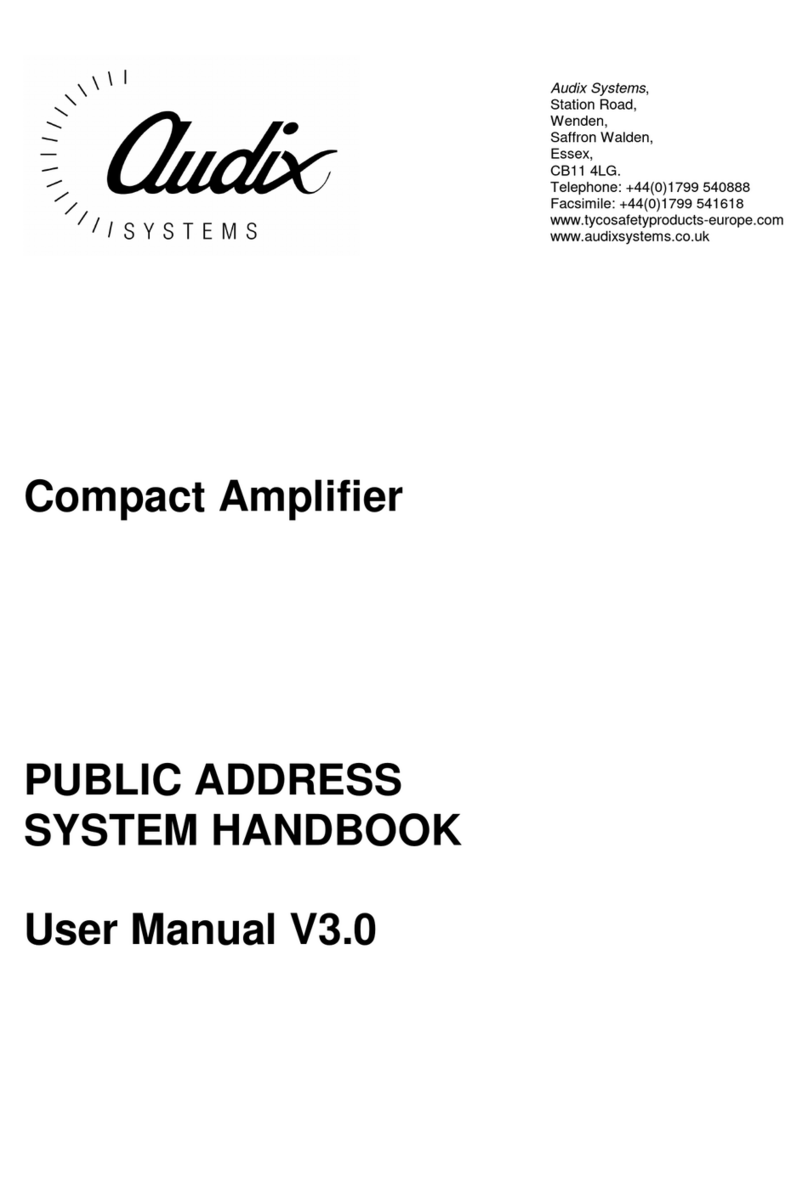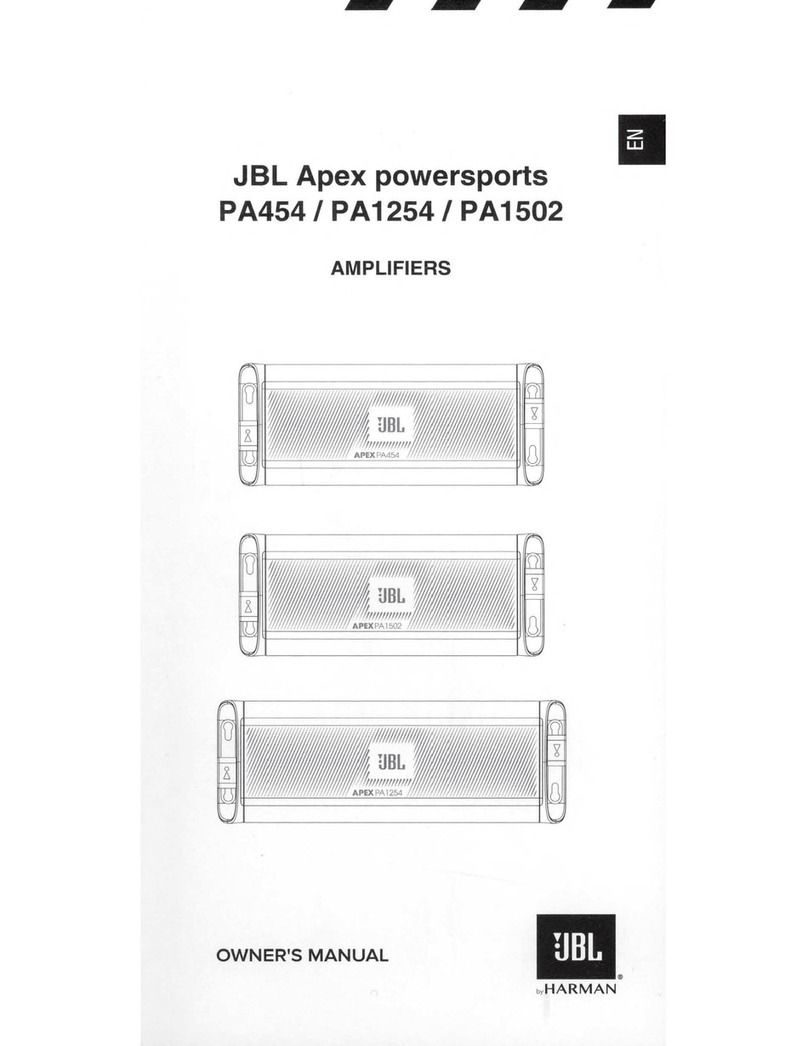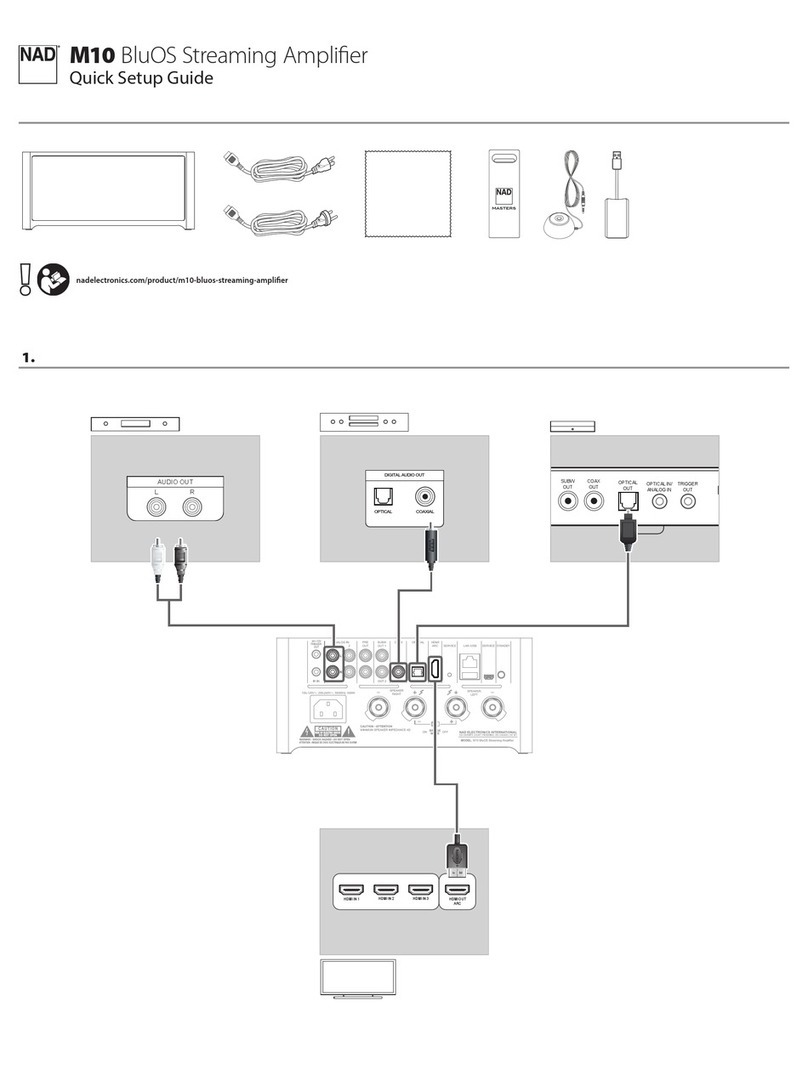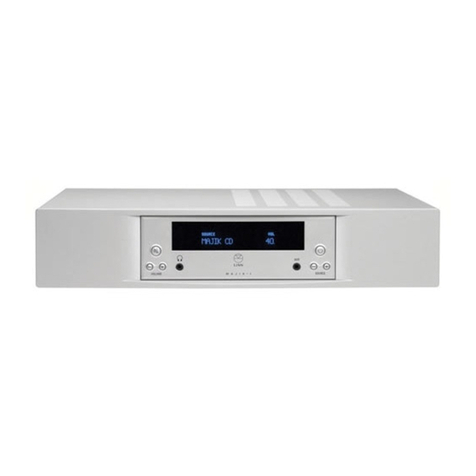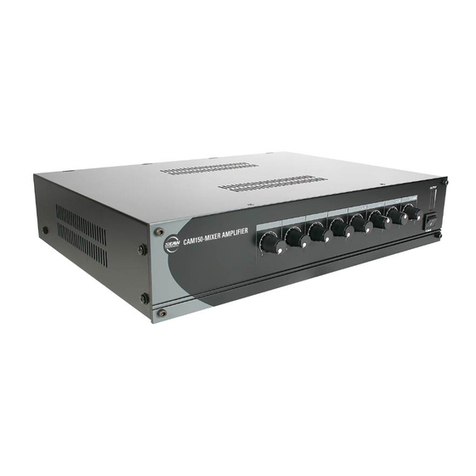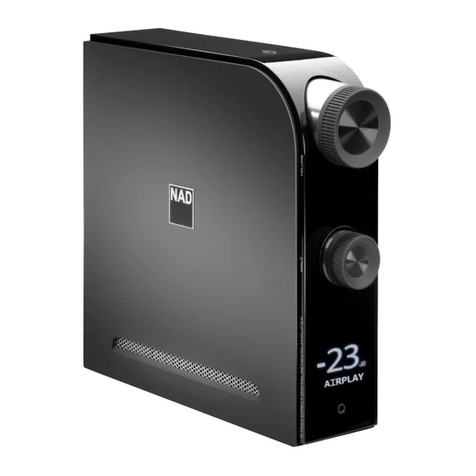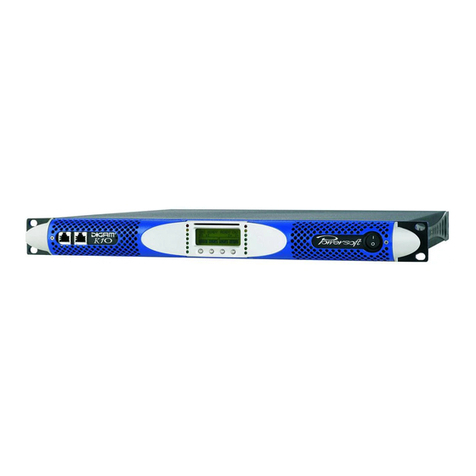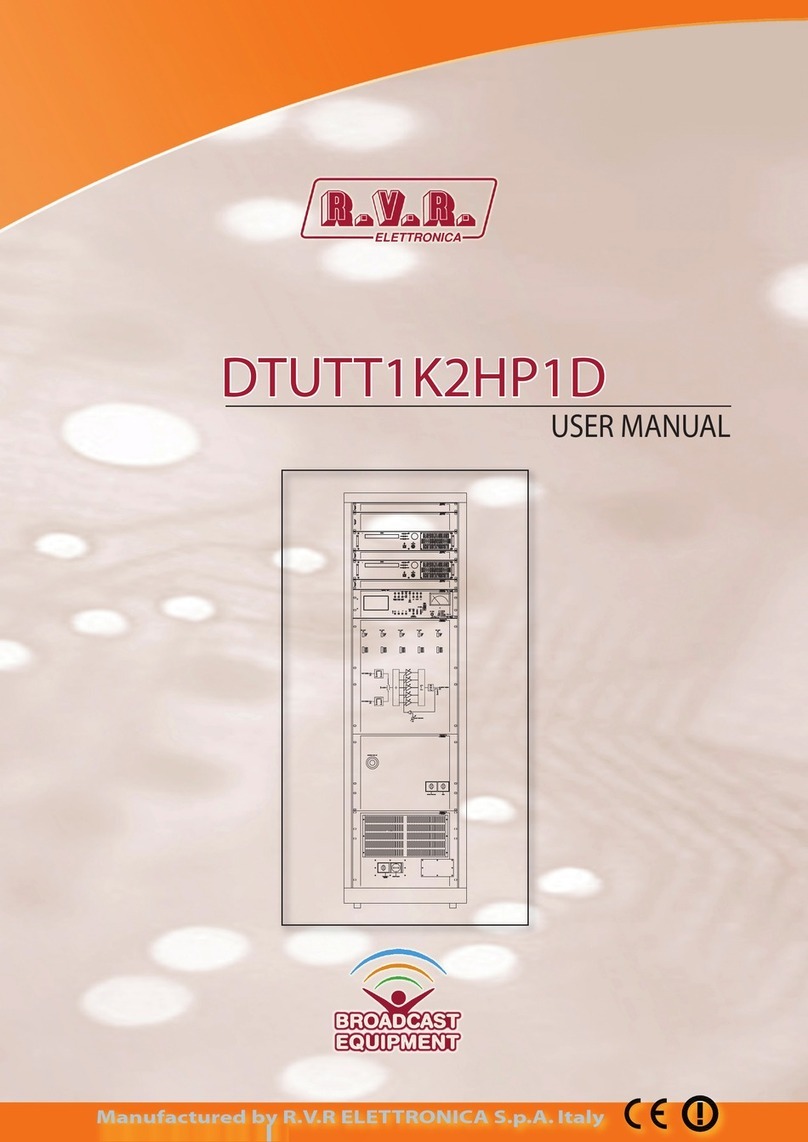Audix CPA240 User manual

Audix Systems,
Station Road,
Wenden,
Saffron Walden,
Essex,
CB11 4LG.
Telephone: +44(0)1799 540888
Facsimile: +44(0)1799 541618
www.tycosafetyproducts-europe.com
www.audixsystems.co.uk
CPA240 Power Amplifier
Manual: V1.31

CPA240 Configurable Power Amplifier
Page 2 of 35
21031 CPA240 manual V1.31.doc
Revision History
Version Modifications Date
1.0 CPA240 Configurable Power Amplifier 15/7/03
1.1 Safety information 17/12/03
1.2 D805 bus adapter card and additions 14/04/04
1.3 Add figures 22/03/05
1.31 Outputs not inputs in table 13.2 27/10/05
© Copyright Audix Systems. 2005
DISCLAIMER
This manual contains information that is correct to the best of Audix Systems knowledge. It is
intended to be a guide and should be used as such. It should not be considered as a sole
source of technical instruction, replacing good technical judgement, since all possible situations
cannot be anticipated. If there are any doubts as to exact installation, configuration and/or use,
call Audix Systems at +44 (0)1799 540888
ACKNOWLEDGEMENTS
Windows™, Windows 95™ and Windows 98™ are trademarks of Microsoft Corporation
All other trademarks are recognised

CPA240 Configurable Power Amplifier
Page 3 of 35
21031 CPA240 manual V1.31.doc
Models Covered
This user manual covers the following equipment
•CPA240 Power Amplifier
Technical Support
Should you require technical assistance regarding the CPA240 Power Amplifier or any other
Audix Systems product please contact our Technical Services Department.
Audix Systems
Station Road
Wenden
Saffron Walden
Essex
CB11 4LG
Tel 01799 540888
Fax 01799 541618
Corporate website www.tycosafetyproducts-europe.com

CPA240 Configurable Power Amplifier
Page 4 of 35
21031 CPA240 manual V1.31.doc
Table of Contents
REVISION HISTORY .................................................................................................................... 2
MODELS COVERED .................................................................................................................... 3
TECHNICAL SUPPORT ............................................................................................................... 3
APPENDIX
A
;
A
MPLIFIER
F
AIL
D
ISABLE
(PA
O
NLY
)..................................................................... 5
1
SPECIFICATION ................................................................................................................... 6
1.1
S
PECIFICATION
.................................................................................................................. 6
1.2
B
ATTERY
C
ONSUMPTION
................................................................................................... 7
1.2.1
Standby Consumption ............................................................................................. 7
1.2.2
Operational Consumption ........................................................................................ 7
2
DESCRIPTION....................................................................................................................... 8
2.1
F
RONT
V
IEW
..................................................................................................................... 8
2.2
B
ACK
V
IEW
....................................................................................................................... 8
2.3
B
RIEF
D
ESCRIPTION
.......................................................................................................... 9
3
AMPLIFIER FEATURES ..................................................................................................... 10
3.1
CPA240
S
IMPLIFIED
B
LOCK
S
CHEMATIC
.......................................................................... 10
3.2
C
ONNECTIONS
................................................................................................................ 11
3.2.1
Amplifier Audio Bus ............................................................................................... 12
3.2.2
Audio Bus selector................................................................................................. 12
3.2.3
Auxiliary Port - Direct Audio Input.......................................................................... 12
3.2.4
Auxiliary Port - Insert ............................................................................................. 12
3.2.5
Auxiliary Port - Amplifier Linking............................................................................ 12
3.2.6
Amplifier Output ..................................................................................................... 12
3.3
A
MPLIFIER
C
IRCUITRY
..................................................................................................... 13
3.3.1
Input Stage ............................................................................................................ 13
3.3.2
Power Stage .......................................................................................................... 13
3.3.3
Amplifier Protection................................................................................................ 13
3.3.4
Amplifier Surveillance, Low Power Idle & Wakeup................................................ 13
3.4
A
MPLIFIER
D
ESIGNATION
&
R
EMOVAL
A
ID
........................................................................ 14
3.5
A
UDIO
B
US
A
DAPTER
...................................................................................................... 15
3.5.1
Wiring and Assembly Detail................................................................................... 15
4
AMPLIFIER CONFIGURATION .......................................................................................... 16
4.1
I
NTERNAL
S
ELECTOR
V
IEW
.............................................................................................. 16
4.2
M
ASTER
S
LAVE
............................................................................................................... 16
4.2.1
Master Slave Configuration Examples .................................................................. 16
4.3
A
UDIO
B
US
S
ELECTOR
.................................................................................................... 17
4.3.1
Audio Bus Selector Configuration Examples......................................................... 17
4.4
F
AULT
M
ONITORING
S
ETTINGS
......................................................................................... 18
5
ADVANCED CONFIGURATION ......................................................................................... 18
5.1
C
HAIN
F
EATURE
.............................................................................................................. 18
5.2
C
ONNECTING
S
IGNAL
P
ROCESSORS
‘I
NSERT
’
(‘S
END
’)...................................................... 18
5.3
V
OLUME
C
ONTROL
G
AIN
O
PTION
..................................................................................... 19
5.4
L
INKING
A
MPLIFIER
F
RAMES
(P
ARALLEL
G
ROUP
).............................................................. 19
5.4.1
Wiring Grouped Amplifiers..................................................................................... 21
5.4.2
Amplifier Group Controller & Slave Settings ......................................................... 22
5.4.3
Amplifier Group Gain Trim ..................................................................................... 22
5.5
C
ONNECTING
L
INE OUTPUTS
............................................................................................ 23
5.6
A
MPLIFIER
L
OW
P
OWER
I
DLE
&
W
AKEUP
.......................................................................... 23
6
MAINS VOLTAGE SELECTION ......................................................................................... 25
6.1
S
ETTING
M
AINS
V
OLTAGE
S
ELECTOR
............................................................................... 25

CPA240 Configurable Power Amplifier
Page 5 of 35
21031 CPA240 manual V1.31.doc
7
FAULT MONITORING FEATURES .................................................................................... 26
7.1
S
UPPLY
M
ONITORING
...................................................................................................... 26
7.2
A
MPLIFIER
M
ONITORING
.................................................................................................. 26
8
RACK MOUNTING THE CPA240 ....................................................................................... 28
9
WARRANTY ........................................................................................................................ 28
9.1
P
ERFORMANCE
............................................................................................................... 28
9.2
D
ELAYS IN
D
ELIVERY
....................................................................................................... 28
9.3
S
TORAGE
........................................................................................................................ 28
9.4
D
AMAGE OR
L
OSS IN
T
RANSIT
(UK) ................................................................................. 28
9.5
D
AMAGE OR
L
OSS IN
T
RANSIT
(E
XPORT
).......................................................................... 28
9.6
L
IABILITY FOR
D
EFECTS
................................................................................................... 29
9.7
E
NVIRONMENT
................................................................................................................ 29
9.8
T
ITLE OF
G
OODS
............................................................................................................. 29
9.9
L
AWS
.............................................................................................................................. 29
10
SAFETY CONSIDERATIONS.......................................................................................... 30
10.1
S
AFETY
C
ONSIDERATIONS FOR
S
YSTEM
D
ESIGN AND
I
NSTALLATION
.................................. 30
10.1.1
Security.................................................................................................................. 30
10.1.2
Electrical ................................................................................................................ 30
10.1.3
Environmental........................................................................................................ 30
10.1.4
Installation.............................................................................................................. 30
10.2
S
AFETY
C
ONSIDERATIONS FOR
S
YSTEM
M
AINTENANCE
.................................................... 32
10.2.1
Safety and Electrical Rating Information ............................................................... 32
10.2.2
Electrical Hazards.................................................................................................. 32
10.2.3
Heat Hazards......................................................................................................... 32
10.2.4
Weight Hazards. .................................................................................................... 32
11
MAINTENANCE............................................................................................................... 33
12
COMPONENT REFERENCE NUMBERS........................................................................ 33
13
REAR PANEL PIN-OUTS................................................................................................ 34
13.1
A
UDIO
I
NPUT
B
US
............................................................................................................ 34
13.2
A
UDIO
O
UTPUTS
............................................................................................................. 34
13.3
FMS
B
US
....................................................................................................................... 35
13.4
A
UXILIARY
P
ORT
(C
HANNEL
I
NSERTS
).............................................................................. 35
13.5
B
ACK
-
UP
S
UPPLY
C
ONNECTOR
S
CHEMATIC
...................................................................... 36
14
ELECTRICAL SCHEMATIC ............................................................................................ 38
15
DETAILED BLOCK DIAGRAM ....................................................................................... 39
APPENDIX A ; Amplifier Fail Disable (PA Only)

CPA240 Configurable Power Amplifier
Page 6 of 35
21031 CPA240 manual V1.31.doc
1 Specification
1.1 Specification
Audio CPA240 Power Amplifier
Power amplifier channels 4 (configurable)
Maximum Power 240 watts (1kHz @ 100V r.m.s)
Amplifier power configurations (switchable) 4 x 60W
1 x 120, 2 x 60W
2 x 120W
1 x 180, 1 x 60W
1 x 240W
Power amplifier channel enable Channel on/off (unused channel power save)
Frequency Response (-3dBu ) 70Hz to 20kHz
Distortion (1kHz at rated power) Better than 1% THD
Cross-talk Better than –60dB
Signal/Noise (20Hz-20kHz rel to 100V) Better than –85dBu
Sensitivity (100V output) 0dBu (+10dBu link option)
Volume control range 0 to –50dB
Power Supply:
Mains supply (V) 230V AC. +/- 10%, 50-60Hz switch options
Backup supply input 24V DC (nominal). To be fused at source 25A max.
Power Consumption max 4 x 60W 510W
Amplifier idle & quiescent consumption Idle Quiescent (wakeup)
1 x master channel configured 121mA 1180mA
2 x master channel configured 146mA 1210mA
3 x master channel configured 171mA 1250mA
4 x master channel configured 195mA 1260mA
General:
Heat Dissipation max (W) 270W
Dimensions(length, width, Height in :mm) 19” Rack Width 2 U High
(89mm x 480mm x 370mm)
Weight (kg) 15 kg
Operating temperature range (°C) 0°C to 40°C
Humidity range 90% non condensing
Meets or exceeds the requirements of BS5839.
Compliant with EMC standards,
EN 61000-6-1-2000, EN 61000-6-3-2001
Standards
Compliant with LVD safety standards; BS
EN60065:1998
Fusing:
Mains fuse rating 1 off 20 x 5mm T 4A H
Battery fuse rating 1 off automotive blade F 25A
Amplifier output stage fuse rating 4 off 20 x 5mm T 6.3A

CPA240 Configurable Power Amplifier
Page 7 of 35
21031 CPA240 manual V1.31.doc
1.2 Battery Consumption
Amplifier power consumption during a mains failure can be calculated by the duration the
amplifier remains at standby plus the additional power drawn during its operation.
1.2.1 Standby Consumption
The table below details the amplifier battery standby consumption for the four possible
master/slave configurations.
Standby consumption is the power used by an idle amplifier during a mains power failure.
During a mains failure voice alarm systems are generally expected to provide 24 hours of
standby and ½ hour of alarm broadcast. Figures for 72-hour standby operation are also
provided.
It is important that all unused channels are configured as slaves as this reduces battery
consumption to a minimum i.e. an amplifier driving a 60watt load should be configured
as a 240W
Amplifier channel
configuration Consumption/hour 24 hours total 72 hours total
1 x master channel configured 140mA 3.38A 10.10A
2 x master channel configured 166mA 3.99A 11.95A
3 x master channel configured 192mA 4.61A 13.82A
4 x master channel configured 216mA 5.18A 15.55A
1.2.2 Operational Consumption
The operational power consumption of an amplifier is effected by a number of factors:
•Speaker load
•Broadcast level
•Signal type
Where the speaker load connected to the amplifier is less than its maximum rated power, the
proportion of power drawn will be reduced. Similarly the level and signal or message type used
during an alarm broadcast can also reduce power consumption. Where a continuous signal is
employed, the consumption can be approximately calculated by the signal voltage across the
load.
However voice alarm broadcasts often contain tone and voice signals. Due to the nature of a
voice messages and the gaps of silence that generally separates the alarm tone and voice
signal the overall average consumption is further reduced.
Generally with normal site perimeters and a combined tone and voice alarm power consumption
would be 33% of the maximum.
Figures below indication the power consumption of an amplifier during nominal and fully power
conditions.
Amplifier total
load 33% consumption Nominal power requirement
(33% for ½ hour) Continuous tone at 100V
into a full load
60W 1.7A 0.9A 5.0A
120W 3.3A 1.7A 10.0A
180W 5.0A 2.5A 15.0A
240W 6.7A 3.3A 20.0A

CPA240 Configurable Power Amplifier
Page 8 of 35
21031 CPA240 manual V1.31.doc
The ‘nominal’ power consumption figure must not be used if a continuous tone alarm is
employed.
2 Description
2.1 Front View
2.2 Back View
25A

CPA240 Configurable Power Amplifier
Page 9 of 35
21031 CPA240 manual V1.31.doc
2.3 Brief Description
The CPA240 power amplifier provides up to four channels of amplification for both public
address and voice alarm applications.
The 100-volt line output stages are robustly designed and are protected against open circuits
and loads that exceed the channel’s rated power, including short circuits.
A thermal shutdown circuit provides further protection of the amplifier’s output stages.
The amplifier is equipped with a number of features that reduce system engineering and
assembly times.
An amplifier audio bus replaces previously hand-wired input cabling with a sixteen ‘zone’ or
‘destination’ ribbon cable.
A link matrix located within the amplifier allows the selection of a single ‘zone/destination’ from
the ribbon bus to each amplifier channel i.e. an amplifier channel may be configured to any one
output of the switching matrix.
Where the ribbon bus cannot be used due to special wiring requirements the auxiliary port ‘D’
type connector allows solder type connection to be made.
Selector switches within the amplifier chassis set the master or slave configuration of each
channel amplifier providing a range of power settings:
•4 x 60 Watt
•1 x 120 Watt & 2 x 60 Watt
•2 x 120 Watt
•1 x 180 Watt & 1 x 60 Watt
•1 x 240 Watt
Paralleling amplifier chassis is achieved by connecting the parallel output on the auxiliary port to
the slave amplifiers. The volume control of the ‘master’ amplifier overrides the volume controls
of the paralleled slaves.

CPA240 Configurable Power Amplifier
Page 10 of 35
21031 CPA240 manual V1.31.doc
3 Amplifier Features
3.1 CPA240 Simplified Block Schematic
Sig Present
Line Monitor
Option
Amp fault
Overload
Monitor jack
Ch.2 Slaving o/p Switch
Sig Present Amp fault
Overload
Monitor jack
Sig Present Amp fault
Overload
Monitor jack
Sig Present Amp fault
Overload
Monitor jack
Channel 1 O/P
Line Monitor
Option
Channel 2 O/P
Line Monitor
Option
Channel 3 O/P
Line Monitor
Option
Channel 4 O/P
Audio Bus
Selector
Link Matrix
16 Way Audio
Ribbon Bus In
(from source)
16 Way Audio
Ribbon Bus Out
(to next amplifier)
Channel 1.
Amplifier
Paralleling
In/Out Port
Auxiliary Port
Audio
Insert/send
Ch.2 Slaving i/p
Switch
Ch.3 Slaving o/p Switch
Ch.3 Slaving i/p
Switch
Ch.4 Slaving o/p Switch
Ch.4 Slaving i/p
Switch

CPA240 Configurable Power Amplifier
Page 11 of 35
21031 CPA240 manual V1.31.doc
3.2 Connections
25A
25A
Schematic shows a typical system connection with D805 audio bus adapter card to convert
matrix controller ‘D’ type cables to the CPA240 audio bus (see Audio Bus Adapter section).
The subsequent amplifiers controlled by that matrix are then connected via the 40 way audio
bus cables. A wake-up connection is also shown.
The upper amplifier is shown with output channels 1 & 2 in use. This would correspond to
2x60W or 1x60W + 1x120W or 1x60W + 1x180W configurations.
The lower amplifies output channel wiring corresponds to a 1x180W + 1x60W configuration.
The CPA240 amplifier is supplied with a one metre IEC plug to socket Mains flex and a battery
connector kit (see Back-up supply connector section for wiring and assembly details).

CPA240 Configurable Power Amplifier
Page 12 of 35
21031 CPA240 manual V1.31.doc
3.2.1 Amplifier Audio Bus
The amplifier audio bus provides a means by which 16 matrix outputs or destinations such as
those provided by the Alpha matrix controller can be connected simply to CPA240 amplifiers
within an equipment rack or suite.
Each amplifier is supplied with a single 40way-ribbon cable.
The cable is connected from the amplifier audio bus input connector to the switching matrix
(where the amplifier is adjacent to the matrix) or to the previous amplifier’s audio bus output
connector.
With the 16 matrix destinations essentially daisy chained to each amplifier an internal selector
matrix allows a single matrix destination to be connected to an individual amplifier channel.
3.2.2 Audio Bus selector
The audio bus selector enables an amplifier channel to be configured to a single matrix
destination or zone connected via the audio bus.
The audio bus selector is located inside the amplifier chassis on the D804 connection card.
3.2.3 Auxiliary Port - Direct Audio Input
Alternative means to connect audio sources to the amplifier is provided by the auxiliary port.
The ‘D’ type plug and socket arrangement allows bespoke cabling to be connected via solder
joints.
3.2.4 Auxiliary Port - Insert
In addition to the direct audio input connections, the auxiliary port provides insert points for each
amplifier channel.
This allows signal processing equipment to be connected or ‘inserted’ into the input of the
amplifier whilst retaining the efficiencies offered by the audio bus connection system.
The audio bus selector provides additional connection points for ‘insert’ configuration.
3.2.5 Auxiliary Port - Amplifier Linking
CPA240 power amplifiers can be connected in a parallel group to provide power for loads
greater than 240Watts. These connections are made using the auxiliary port. See ‘Amplifier
Configuration’.
3.2.6 Amplifier Output
The amplifier output plug and socket assembly provides screw terminals for four 100V
loudspeaker circuits and monitoring zero volt connections.
The screw terminals allow conductors of up to 2.5mm² to be connected.
Warning, high voltages exist on these terminals.

CPA240 Configurable Power Amplifier
Page 13 of 35
21031 CPA240 manual V1.31.doc
3.3 Amplifier Circuitry
3.3.1 Input Stage
A four channel balanced input stage provides drive to the amplifier’s power stage.
The gain of each channel can be adjusted via the front panel volume controls.
Signal present and overload LEDs provide signal status indication for each channel.
The signal present LED also indicates amplifier ‘wakeup’.
3.3.2 Power Stage
The amplifier power stage is designed as a removable heatsink assembly, which allows for
quick assembly and access to specialised settings.
This power block assembly includes four 60Watt power stages and input ‘master’/‘slave’
switching.
3.3.3 Amplifier Protection
The amplifier’s output stages are protected against both open circuits and loads that exceed the
channel’s rated power, including short circuits.
A non-latching thermal shutdown circuit provides protection against damage to the output stage
due to overheating. The front panel ‘Temp’ LED indicates amplifier over temperature.
Ultimate protection of the MOSFET power devices and the power supply is provided by
individual 6.3AF channel fusing.
3.3.4 Amplifier Surveillance, Low Power Idle & Wakeup
In an attempt to reduce standby battery usage to a minimum, in normal operating mode the
amplifier shuts down when not in use.
To allow continuous and reliable monitoring of the amplifier and loudspeaker lines the amplifier
is periodically enabled or ‘Woken up’.
The ‘wake up’ signal is provided by the matrix controller approximately two seconds before the
matrix routes the 20kHz surveillance pulse. This allows adequate time for the amplifiers power
stage to reach its normal operating quiescent condition.
Once the surveillance signal has passed through the system the ‘wake up’ signal is removed.
The surveillance procedure is repeated every 30 seconds.
If required the low power mode can be disabled. See advanced configuration.

CPA240 Configurable Power Amplifier
Page 14 of 35
21031 CPA240 manual V1.31.doc
3.4 Amplifier Designation & Removal Aid
The CPA240 front panel features both removal aid points and designation cut outs.
The designation feature allows a cost effective printed pager label to be fitted to the amplifier
without glues or tapes.
See method statements below:

CPA240 Configurable Power Amplifier
Page 15 of 35
21031 CPA240 manual V1.31.doc
3.5 Audio Bus Adapter
The Audio Bus Adapter provides a conversion between the two output ‘D’ type connectors on
the Alpha matrix controller or V32EBPU bypass unit, and the single 40 way ribbon connector
bus of the CPA240 amplifier.
One adapter card is required per matrix controller and is to be mounted on the first amplifier to
which that matrix is connected.
The kit also includes two CA30 ribbon cables that connect from the adapter card ribbon header
to the ‘D’ type plugs.
Screw terminals, on the adapter card provide a connection for the amplifier ‘wake up’ signal
where used (options of positive and negative switching is available).
3.5.1 Wiring and Assembly Detail

CPA240 Configurable Power Amplifier
Page 16 of 35
21031 CPA240 manual V1.31.doc
4 Amplifier Configuration
4.1 Internal Selector View
16
15
Amplifier Link Gain Trim
Amplifier Link
(remove for Slave Amp)
Channel 1. Channel 2.
CH1 +10dB
CH2 +10dB
1
Amplifier
Channel
Send
Chain
I/P
Master
CH2
Slave
Selector Cable (4 off)
4
3
2
Channel 3.
CH3 +10dB
Channel 4.
CH4 +10dB
Mains
Always Wakeup
Not Fitted
MonitorEnable
Battery
Charger
D800 Control Card
Slave MasterD804 Connector Card
3
10
1214 4
68
913 11 5
7
2
Audio Bus
Channel
1
Slave
Master
CH3
CH2
SW2
D801 Power Block
Slave Master
CH4
Master
Slave
Slave Master
CH3
SW3
CH4
SW4
Fuse CH3 Fuse CH4Fuse CH1 Fuse CH2Output Stage Fusing
4.2 Master Slave
The CPA240 amplifier is equipped with four individual 60-Watt channels.
Setting of the ‘master/slave’ selectors allows the channels to be paralleled, providing 60, 120,
180 & 240 Watt configurations.
There are two ‘master/slave’ selectors per channel they are located on the Power Block (D801)
and rear connector card (D804). ‘CH2’ selects channel 2 as a master or slave etc.
Note: Both switches on a channel MUST be set to the same position.
When wiring to a paralleled amplifier the input and output signal cabling is to be connected to
the master channel only.
4.2.1 Master Slave Configuration Examples
4 x 60 Watt.
•Set all Master/Slave switches to ‘master’ (factory setting).
•Wire/configure channel 1 input/output signals to amplifier channel 1 etc.
•Wire/configure channel 2 input/output signals to amplifier channel 2 etc
•Wire/configure channel 3 input/output signals to amplifier channel 3 etc
•Wire/configure channel 4 input/output signals to amplifier channel 4 etc
2 x 120 Watt.
•First amplifier group: Set CH2 M/S switch to ‘slave’ (this parallels channel 2 to channel 1
master).

CPA240 Configurable Power Amplifier
Page 17 of 35
21031 CPA240 manual V1.31.doc
•Second amplifier group: Set CH3 M/S switch to ‘master’ and CH4 to ‘slave’ (this parallels
channel 4 to channel 3 master).
•Wire/configure first amplifier group input/output signals to CH1 (master).
•Wire/configure second amplifier group input/output signals to CH3 (master).
1 x 240 Watt.
•Set all Master/Slave switches to ‘slave’ this parallels channels 2, 3 & 4 to channel 1 master
•Wire/configure channel 1 input/output signals to amplifier channel 1 etc.
4.3 Audio Bus Selector
The Audio Bus allows an amplifier within a system to be connected to a switching matrix such
as an Alpha and/or other CPA240 amplifiers via a ribbon cables.
These ribbon cables couple the sixteen matrix outputs (destinations or zones) to the audio bus
channel pin headers located on the D804 connector card within the amplifier.
Configuring each amplifier master input channel involves linking the desired Audio Bus channel
(matrix zone) to the amplifier input channel using one of the four two way selector cables
supplied.
Note: See advanced configuration for:
•Connecting two or more input channels to the same Audio Bus ‘zone’ within a single
amplifier (Chain).
•Connecting (inserting) external signal processing equipment (Send).
4.3.1 Audio Bus Selector Configuration Examples
Connecting matrix zone output 6 to amplifier channel 1 (180W)
•Connect one end of the two way selector cable to header 6 of the Audio Bus Channel
•Connect the remaining end to Amplifier Channel ‘I/P’ header 1
•First amplifier group: Set CH2 & CH3 M/S switch to ‘slave’.
•Wire/configure first amplifier group input/output signals to CH1 (master).
Connecting matrix zone output 8 to amplifier channel 4 (60W)
•Connect one end of the two way selector cable to header 8 of the Audio Bus Channel
•Connect the remaining end to Amplifier Channel ‘I/P’ header 4
•Second amplifier group: Set CH4 M/S switch to ‘master’
•Wire/configure second amplifier group input/output signals to CH4 (master).
I/P
Chain
Send
1234 1 8
9 16
Audio Bus Channel
Zone 6Zone 8
Master
Slave
Slave
Master
1
4

CPA240 Configurable Power Amplifier
Page 18 of 35
21031 CPA240 manual V1.31.doc
4.4 Fault Monitoring Settings
The amplifier provides fault indications for its power sources.
•Mains
•Battery (backup supply)
•Changer
These fault indications may be disabled by removing the appropriate link located on the D800
control card.
5 Advanced Configuration
5.1 Chain Feature
Each channel is provided with an additional header at its input so that another input channel
may be connected to it.
The feature allows a ‘zone’ connected to an input channel to then be ‘Chained’ to a second
input channel.
This can then be repeated for the other channels if required.
Example shows connection of amplifier inputs 1, 2 & 3 to Zone 1. Amps 1, 2 & 3 will be set as
Masters.
5.2 Connecting Signal Processors ‘Insert’ (‘Send’)
Additional signal processing equipment can be connected into the audio bus – amplifier path.
This is achieved by using a selector cable to connect the required audio bus ‘zone’ to the
appropriate channel ‘Send’ (Do not connect to the ‘I/P’ header).
This will route the selected audio bus zone to the auxiliary port connector ‘Send’ output
terminals.
The input of the signal processing equipment can then be wired to this output. The output of the
signal processing equipment can then be wired back into the amplifier signal path via the ‘Direct
Audio Input’ connections.
I/P
Chain
Send
1 2 3 4 1 8
9 16
Audio Bus Channel
Zone 1

CPA240 Configurable Power Amplifier
Page 19 of 35
21031 CPA240 manual V1.31.doc
Example shows connection of amplifier input 1 to direct to Zone 8 and input 2 to Zone 9A/9B
via a Graphic EQ and 37W aux port.
Note: Shorting the ‘Send’ signal path will significantly reduce the signal level on the
audio bus ‘zone’. This will in turn affect all equipment connected to this ‘zone’.
5.3 Volume Control Gain Option
The nominal gain of the amplifier with the volume controls set to maximum is +42dB (0dB i/p –
100V o/p). An additional 10dB gain for each channel is available by fitting the ‘CH+10dB’ link.
Links for each channel:
•CH1+10dB
•CH2+10dB
•CH3+10dB
•CH4+10dB
The link headers are located on the D800 control card (lower front).
5.4 Linking Amplifier Frames (Parallel Group)
The CPA240 provides an amplifier linking or grouping facility via additional circuitry and the
auxiliary port connector. This allows a group of amplifiers to be paralleled giving increased
power to a speaker circuit i.e. paralleling 3 x 180 Watt amplifiers could drive a 540 Watt speaker
circuit.
The maximum permitted amplifier group is five frames i.e. up to 1200Watts
General configuration:
•One amplifier within the group is set as a ‘controller’ the other as ‘slaves’.
•Only channel 1 of the amplifier is ‘linked’ while the other channels are configured as slaves
(to required power) see ‘master/slave’ section.
•Only channel 1 volume control of the control amplifier adjusts the group level.
•The output of each amplifier within the group is paralleled using the speaker circuit output
cable (manually wired).
•All amplifiers within a group must have the same power configuration i.e. 180 Watts
•All amplifiers within the group must be adjusted to have an identical power output.
I/P
Chain
Send
1 2 3 4 1 8
9 16
Audio Bus Channel
I/P O/P
Send Return
2 2
EQ
Zone 8
Zone 9A
Aux Port 37W
Send 2
Ret 2
Zone 9B
Ret 1
Return
1
Aux Port
37W
Amp 1
Amp 2

CPA240 Configurable Power Amplifier
Page 20 of 35
21031 CPA240 manual V1.31.doc
•Each amplifier within the group must be connected together via the ‘link’ feature.
Table of contents
Other Audix Amplifier manuals
Popular Amplifier manuals by other brands
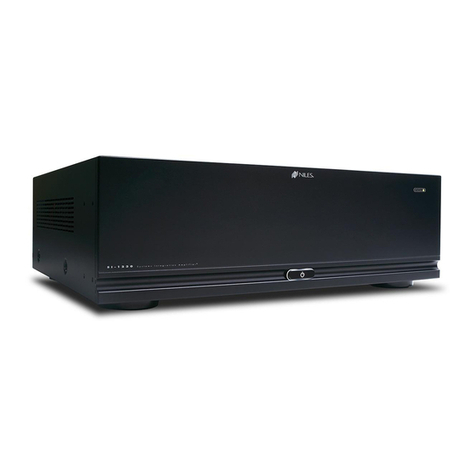
Niles
Niles SI-1230 Series 2 installation guide

Bad Cat
Bad Cat Hot Cat Series operating manual
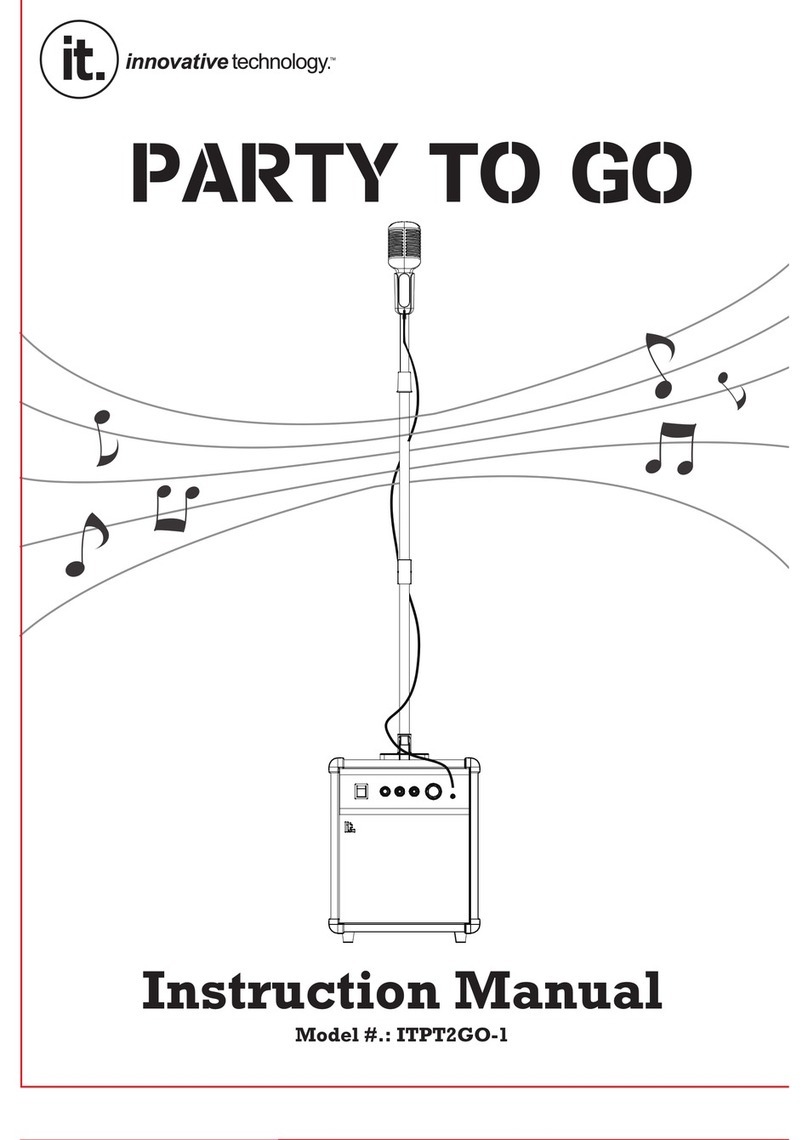
Innovative Technology
Innovative Technology Party To Go ITPT2GO-1 instruction manual

Blaze
Blaze PowerZone Connect 122 quick start guide
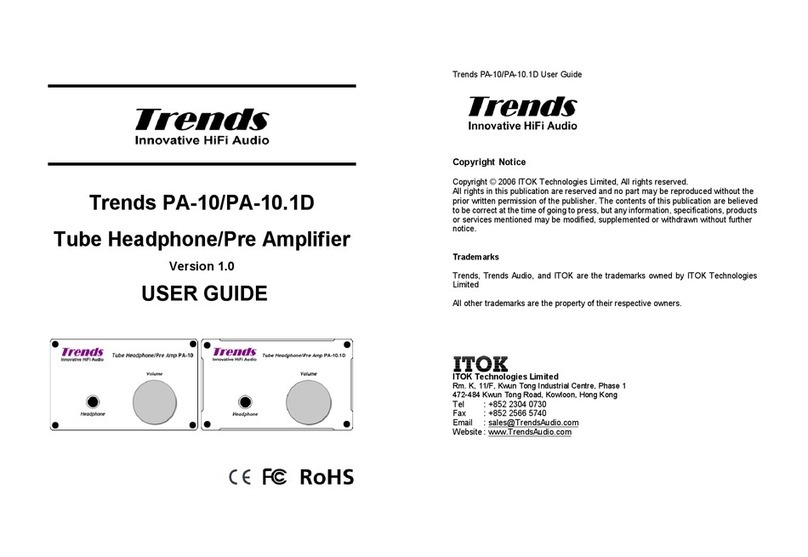
Trends Audio
Trends Audio PA-10 user guide
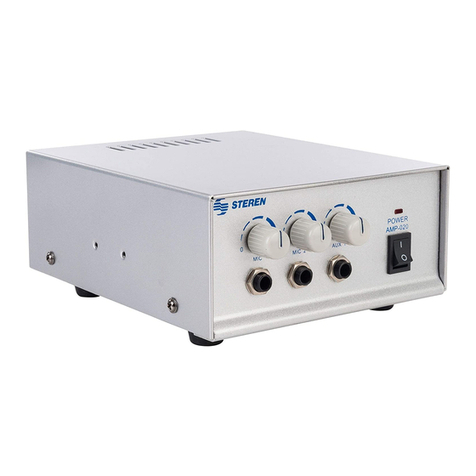
Steren
Steren AMP-020 instruction manual
